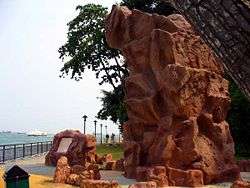Long Ya Men

Long Ya Men (Chinese: 龙牙门; pinyin: lóngyámén) or Dragon's Teeth Gate, is the name given to a craggy granite outcrop that formerly stood at the gateway to Keppel Harbour in Singapore. The rocky outcrop served as navigational aids to ancient mariners sailing through the swift waters of the narrow channel between them, but was subsequently destroyed by the British in 1848 to widen the channel for larger vessels to sail through. In 2005, a symbolic replica was erected by the Singapore government near its original site to mark the role it played in Singapore's maritime history.[1]
Long Ya Men was documented in Wang Dayuan's travelogue Daoyi Zhilüe, and in the Mao Kun navigational map historical maritime annal Wubei Zhi said to date from the voyages of Ming dynasty's Admiral Zheng He. Long Ya Men in the map was also used to refer to the strait between Sentosa island and Labrador Point, and named after a pinnacle of stone that was called Batu Berlayar, which means “Sail Rock” in Malay.[2] Another suggestion is that it refers to the Singapore Main Strait south of Pulau Satumu.[3] The Long Ya Men's unique features was said to have assisted Zheng He in navigating the waters around Singapore during his seven maritime voyages to the west between 1405 and 1433 AD.
History
Historically the rocky outcrop was known locally by the Malays in earlier times as "Batu Berlayar" ("Sailing Rock") near the present site of Labrador Park, off Pasir Panjang Road. Another rock outcrop used to stand on the opposite shore of Tanjong Rimau on Sentosa Island. These two rock outcrops once formed a gateway at the western entrance to Keppel Harbour. British sailors named the more prominent Batu Berlayar, "Lot's Wife" in reference to the biblical story of the wife of Abraham's nephew. She was transformed into a pillar of salt when she disobeyed divine orders not to look back at the destruction of Sodom while fleeing from the city.[4]

In the 14th century, the ancient mariner and trader Wang Dayuan, is said to have sailed through this passageway. In his travelogue, he recorded that the Fujian mariners knew about these two rock outcrops as Long Ya Men, because they reminded them of the two pegs at the bow of their ships. These two pegs were known to the mariners as "Dragon's Teeth".[5]
The Keppel passageway was used by Asian and early European sailors and traders for hundreds of years to sail past Singapore. Between 1405 and 1433, Zheng He made seven voyages to more than 30 countries, travelling in fleets of up to 300 ships to the South Pacific, Indian Ocean, Persian Gulf and Africa. The admiral travelled on the order of the Chinese Emperor to establish trade relations with countries west of China. He is believed to have sailed through the waters off Labrador Park, though whether he landed in Singapore is uncertain.[6] In the 17th century, the passageway was abandoned in favour of the wider and more open Main Straits, that lies south of Pulau Satamu, where Raffles Lighthouse stands today.[4]
Sir Stamford Raffles of the British East India Company did not know of the "Lot's Wife", or the deep water harbour it led to when he landed in Singapore in January, 1819. William Farquhar, the first British Resident and Commandant of Singapore, wrote to Raffles on 2 September 1819 that he had founded a new harbour west of the settlement. The two rock outcrops were subsequently blown up by the Straits Settlements Surveyor, John Thomson, in August 1848 in order to widen the entrance to the new harbour.[4]
Commemoration
In July 2005, a 6m high stone replica of Long Ya Men was put up near its original site by a joint collaboration involving the Singapore Tourism Board, the Maritime and Port Authority of Singapore and the National Parks Board. This was part of a three-month-long celebration of the 600th anniversary of Zheng He's maiden voyage, which began in Nanjing, China. A storyboard telling Long Ya Men's significance to Singapore and Zheng He's story, was also put up next to the replica.[7]
The authorities had initially planned for the replica to replace the red Berlayer Beacon, but the Singapore Heritage Society was against the decision, saying the beacon was itself a heritage site and should not be destroyed because the beacon has been at Labrador Park since the end of World War II. The replica was finally built just meters away from the beacon. The authorities hope the symbolic replica can serve to preserve the memory of Long Ya Men, which is an important part of Singapore’s maritime history, for future generations and visitors familiar with the historical voyages of Zheng He.[8]
See also
References
- ↑ Sim, Glenys (23 March 2005). "Dragon's tooth replica to mark anniversary of Chinese explorer". The Straits Times.
- ↑ "Wang Da Yuan". History SG.
- ↑ John N. Miksic (15 November 2013). Singapore and the Silk Road of the Sea, 1300_1800. NUS Press. p. 197. ISBN 978-9971695743.
- 1 2 3 EndNote: Information obtained from on-site information board by NParks.
- ↑ "Fact Sheet: "Long Ya Men"". Singapore Tourism Board. Retrieved 2007-04-26.
- ↑ "Three month celebration to mark 600th year of exploration". The Straits Times. 25 March 2005.
- ↑ "Official Launch of the Singapore Zheng He 600th Anniversary Celebrations on 30 June 2005". Singapore Ministry of Foreign Affairs. Retrieved 2007-04-26.
- ↑ Pereira, Marcel Lee (7 September 2005). "Historic Dragon's Tooth Gate reborn at Labrador Park". The Straits Times.
External links
Coordinates: 01°15′45.06″N 103°48′18.68″E / 1.2625167°N 103.8051889°E